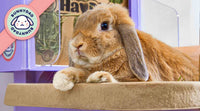Bunny Blog: "Grooming Your Rabbit (Part 2)"
Hey there, BunnyGang
Welcome to part 2 of our blog on grooming your bunny. Part 1 gives an overview of the grooming process and discusses building a routine with your pet. It also goes over the brushing, trimming, and clipping, so be sure to check that blog post out if you haven’t already!
https://guineadad.com/blogs/bunnydad-blogs/grooming-your-pet-rabbit-part-1
Part 2 here will deal with the more medical aspects of your grooming routine, including ear cleaning, eye health, scent glands, and inspecting your rabbit for parasites and skin conditions.
An Overview of the Medical Side of Grooming:
Did you know that a quick daily inspection of your rabbit can be the best way to catch and prevent medical issues before they develop into painful, dangerous, and expensive conditions? Early detection can be relatively simple for many of the common threats to a rabbit’s well-being, when a few daily grooming elements are used. Probably the easiest and most significant aspect of early detection of problems in your rabbit's health is a daily inspection of your rabbit. That’s it! Look them over every day! Looking at your rabbit’s fur, skin, eyes, nose, ears, underside, and paws, is the best way to know what’s going on with your bunny, and catch problems as they arise. In each of the sections below, we’ll cover in greater detail exactly what signs to look out for when checking each of these parts of your pet.

Tool Review:
“Grooming Your Rabbit (Part 1)” gives a list of all the tools you’ll need to groom your rabbit. Below are the items you’ll need specifically for the medical side of your grooming routine, followed by a more in-depth discussion of how each one relates to the process.
- CuddleComb* or slicker brush
- Mineral oil for cleaning sensitive scent gland areas on the rabbit
- Eye wash
- Cotton balls or gauze pads (for cleaning & stopping any potential bleeding)
- Q-tips for outer ear cleaning and scent gland cleaning
-
Disinfectant for cuts*, scratches, and any other open wounds.
(Betadine and ChlorhexiDerm are good over-the-counter options, and are available at most pharmacies.) - Flea treatments
-
Flea comb
(*Note: Avoid using Peroxide on deep cuts or punctures and NEVER use products that contain any painkillers/anesthetics like lidocaine.)
(*Note: Small shallow wounds can be cleaned with a clean cotton ball or gauze pad and some Betadine. If cuts are large, jagged, deep, or appear infected, or if you aren’t sure – go to your vet or emergency veterinary hospital immediately.)
The Importance of Brushing:
Now, we know that regularly brushing our rabbits is important for their physical comfort. It helps them regulate their body temperature, and reduces the chances of developing mats and tangles, especially during their heavy shedding periods. As it turns out, brushing our rabbits’ fur has some other important health factors beyond these.
Regularly brushing a rabbit’s fur is vitally important in reducing the amount of fur they ingest. As a creature that is constantly grooming itself, and shedding its fur coat every few months, ingesting small amounts of hair is inevitable. Due to the way rabbits groom themselves, small amounts of hair are perfectly normal for a rabbit’s stomach and digestive system and will usually pass right through without any issues. The problems that arise when a rabbit ingests an excessive amount of hair, however, can be rather serious and may require emergency veterinary intervention. This happens when their GI tracts become blocked, obstructing their intestines and making it difficult for food to pass through. A GI tract blockage, or GI stasis, is a potentially life threatening condition in rabbits, so if you notice a drastic decrease in the amount of bowel movements your rabbit produces, or if their stomachs feel bloated and tight, take them to see their veterinarian immediately. A great way to avoid any blockages to your rabbit’s GI tract is to brush their fur daily (or every other day, depending on breeds) and remove any excess hair from their environment. In case you needed more motivation, parasites can live and breed in loose fur as well. Regular brushing is the easiest way to prevent a whole host of medical concerns for your bunny.

Inspection:
Lastly, as you brush your rabbit, make sure to thoroughly inspect their fur and skin for any signs of rashes, raw or broken skin, as well as bald patches and any bruising. There are many treatments for various skin conditions your rabbit might contract, and bald patches can be an indicator of many different issues as well, including the presence of parasites. For any concerns, abnormalities, or questions, always contact your local vet.
Bruises that are less severe should heal on their own, but it’s still important to locate them so that you know where your bunny will be comfortable being held and stroked, and where it might hurt them.
Feet:
While examining your bunny's fur and skin, this is a perfect time to check the tops and bottoms of their feet. Rabbit's only have fur on the bottoms of the feet, no paw pads, so their feet can be quite delicate. They are also typically not huge fans of people touching their paws, as they can be sensitive, so it may take some repetition before your bunnies welcome this as a normal part of their grooming regimen. We recommend gently inspecting the tops and bottoms of your rabbit paws daily, checking for any bruising, cuts or wounds, or mats between their toes. This will help your rabbits resist less, as they accept it as a part of their daily grooming regimen. If you do find any mats, remove them carefully, using the techniques outlined in our "Grooming Your Pet (Part 1)" blog. If the fur is worn down on their feet and skin is exposed, extra care will need to be taken to keep their feet clean, as well as their litter boxes, as this can lead to infection if the skin on their feet becomes broken. If you believe your rabbit's feet might be infected, or if the fur isn't growing back promptly, keep cleaning and drying your rabbit's feet throughout the day, and seek advice from your vet.
Cleanings & Application of Medications:
We can’t always communicate to our pets exactly what we need to do to help them. It can be uncomfortable and even frightening for an animal to be handled in certain ways, so maintaining a gentle and reassuring touch and tone of voice is always important, and whenever possible, using slow deliberate movements that your bunny is able to see. This is also why building up trust between you and your bunny is a crucial part of creating a successful care routine. Even rabbits who deeply love and trust their humans, however, will very likely try to escape during a moment of discomfort. This is where the Bunny Burrito method can help enormously. Wrap a clean, soft blanket or towel around your bunny, swaddling them much like a baby human. Just like with infant humans, this can provide a soothing, calming feeling, like a full-body hug. Conveniently, a well-administered Burrito wrap also makes escaping much more difficult for your furry friend.

Ear cleaning:
If you’re not a medically-trained professional, avoid using Q-tips in your rabbit’s ears, as Q-tips present the risk of potentially puncturing your rabbit’s ear drum if they go too deep inside. Also, bits of the cotton tip can easily break off in your rabbit’s ear and get stuck, and then lead to the need for extraction by a specialist. Instead, it’s always better to use a cotton ball to swab the ear, breaking up any chunks of earwax you can, then letting your rabbit shake it out themselves. Don’t worry, if they’re able to shake something out of their ears, they’re certain to try.
Keeping a rabbit’s inner ears dry is also important to avoid them contracting ear infections, and a quick daily inspection and wipe with a cotton swab is a good way to stay on top of this issue.
Rabbit ears should be inspected daily for signs of parasites, skin disease, dampness, and injuries, and earwax should be cleaned out whenever you notice it building up, or roughly once a week.
When adding medication to your rabbit’s ears, pull your rabbit in close to your body to help brace them. It’s never comfortable having someone squirt liquid in your ears (especially if your ears were already bothering you), so your rabbit may very well try to escape at this point. Luckily, you were prepared for this. Gently, yet firmly restrain your rabbit’s body, while allowing their head to move freely. Administer the medicine by splitting the intended dosage into 3 or 4 separate attempts. This is because each time you do, your rabbit is likely to shake some of the medication out. This behavior is totally fine, and will even help the medication work its way deeper into the ear canal, but in case your rabbit shakes before the medication can get inside and loses some, better to have split up your attempts. Once the full dose has been administered, hold the tip of your rabbit’s ear as you gently massage the base of the ear, to help work the medicine all the way down.
Eye cleaning & health:
Keeping your bunny’s eyes clear of hay and fur will help prevent irritation and potential infections, and will contribute greatly to their ocular health. As necessary, use a warm damp cotton ball to gently clean the rim around the eye. Never touch the actual eye when attempting to wipe debris away, as this can scratch your rabbit's cornea. If you need help clearing fur away from your rabbit’s eyes, you can use your flea comb to help part their fur and get access to your bunny’s eyes. Just make sure the comb is clean and flea-free, of course! If your bunny requires a more thorough eye wash, consult your veterinarian first, then find a rabbit-safe eyewash and gently administer the drops while holding your rabbit in place.
Scent glands:
Like many other naturally territorial animals, Rabbits have scent glands they use to identify each other and mark an area or item as theirs. When your rabbit feels comfortable and happy in their space, you've likely seen them rub their chins on furniture, rugs, their toys, maybe even you. Yes, this is slightly objectifying, and quite possessive, but in the case of your pet, it should be taken as a high compliment. Your rabbit loves you and has claimed you as theirs. This is because rabbits have scent glands underneath their chins. These glands should be checked often for bits of hay or other debris, or matted fur that might obstruct them. A rabbit's chin may need a gentle wipe occasionally, but the chin gland isn't likely to need much cleaning. Their anal glands, however, located next to the rectum, will need occasional cleaning. This will depend on your bunny and their activities, but it's a good idea to check for debris about once a month.
Cleaning Equipment:
Mineral oil & Q-tips for cleaning sensitive scent gland areas on the rabbit, cotton balls or gauze pads to wipe up the area afterwards, and finally, a disposable cup of warm water.
Using both your hands to support your rabbit, stand them up on their hind legs on top of your lap. Then, scoot their butts forward, so you’ll be able to reach the area on either side of their rectum. Gently pull apart the fur on either side of the rectum to uncover these small, roughly nostril sized pockets on either side. These are the rabbit’s scent glands. Dip a Q-tip in the warm water, and then gently use it to clean out any debris from the scent glands. After the area is clean, use a cotton swab or gauze pad to dab the area dry, and you’re ready to move on to the scent gland on the other side.
Cuts, scrapes, & other open wounds:
Disinfectant and Cotton balls or gauze pads (for cleaning & stopping any potential bleeding)

Parasites:
Parasites like fleas, ticks, and mites can find their way into our homes through a myriad of ways, including traveling in on our shoes and clothing, in bags of hay from farms or feed stores, or by being passed on from other animals. Keeping your pets indoors, maintaining a hygienic living space, and regular grooming are the best ways to protect your pets from parasites. Even so, it is unfortunately impossible to ever completely eliminate the risk of contracting parasites, especially when pets come into contact with the outdoors. Don’t Despair. There are reliable treatments to free your pet from the pain and discomfort of parasites, as well as man good preventative measures to take, including thorough inspections of your pet as part of your daily grooming routine.
Whenever grooming, always make sure to thoroughly check your rabbit’s fur and skin for signs of parasites, rashes and skin disease. Mites, fleas and ticks and skin disorders can all pose significant threats to your rabbit’s health, and should be treated immediately to avoid them spreading.
Some signs to look for: Black fleas are usually found near a rabbit’s head, face, or genitals. Ticks may be found anywhere on the rabbit. Mites appear as dandruff and may cling to fur and skin. A tick is an oval shaped parasite that may be crawling on rabbit's fur or attached to your rabbit's skin. Watch your rabbit for signs of these parasites. If your rabbit is excessively scratching, has flaky skin with bald patches, or appears to have dandruff on their fur near the skin, these can all be signs of parasites.
Ear mites, also known as Psoroptes Cuniculi, are a common concern in rabbits, though are relatively easy to catch, as you’ll probably be able to see the dark specs of waste they leave behind. This is extremely irritating to your rabbit, so they’re almost certainly going to let you know that something is wrong.
Ear mites can cause severe damage to a rabbit's ears and pose further health risks if left unattended, though are easily treated with proper care and medication. Make an appointment with your vet immediately if you suspect your rabbit has contracted them.
Regular inspections, care, and checkups will protect your rabbit from a host of painful complications and skin conditions, and save you a lot of money in the long term.
If you notice any raw skin or bald patches on your rabbit’s fur or ears, or if they’re constantly scratching and seeming itchy, these can sometimes be a sign of parasites like mites. In the ears, you may be able to see a mite infestation once it’s gotten severe, by seeing the actual mite colonies themselves, or by the black specs of fecal matter they leave behind. Whatever the case, if you believe your pet might have signs of parasites, it’s always better to check with your vet for specific advice on medications.
Medication:
Your vet will provide you with the proper medications and dosages to to treat your pet's condition. Some common flea and tick medications for rabbits include
To treat mites, three injections of Ivermectin, an anti-parasitic drug, two weeks apart, is a common treatment, though topical treatments are also available, depending on your rabbit’s weight and age.
CAUTION!
Frontline products should NEVER be used on rabbits or any other small animals as it can result in severe seizures, neurological damage, and death. Sprays, “bombs,” and flea shampoos of all types, even those labeled to be “rabbit safe” are never recommended. When addressing a parasite issue, use only the medications recommended by your vet, and closely monitor the dosage. In cleaning your rabbit's living space (as well as your own) after an outbreak of fleas or mites, be sure to vacuum thoroughly, then dispose of the vacuum bag outside, and clean off the bristles of the vacuum head by submerging them in an inch of soapy water. Ideally, when vacuuming a small enough area or a section with a high concentration of parasites, use a vacuum hose or hand vacuum with no fibrous connections. Finally, steam clean the carpet, allowing it to dry completely before allowing your rabbit to return to the area. Your flea comb is the best tool for removing dead fleas from your rabbit's fur, and laying down a white sheet on the floor can help you verify whether you have successfully removed all the fleas from an area.
Bathing rabbits in water is not recommended as they often become agitated and can injure themselves trying to escape or by thrashing around.
Rabbits are adorable and personable animals and they make terrific companions. Whether you live alone, with roommates, or have a large family with children, a rabbit is certain to add warmth and love to your home. We hope that tips for the medical aspects of grooming are a helpful resource as you bond and care for your furry friend.
See you soon, BunnyGang!
~ BunnyDad
“Grooming Your Rabbit (Part 1)”
https://guineadad.com/blogs/bunnydad-blogs/grooming-your-pet-rabbit-part-1
For more great guinea pig content, check out our other blog posts at: https://guineadad.com/blogs/news









